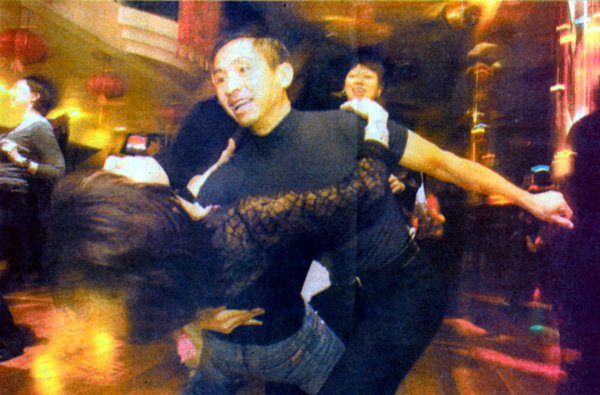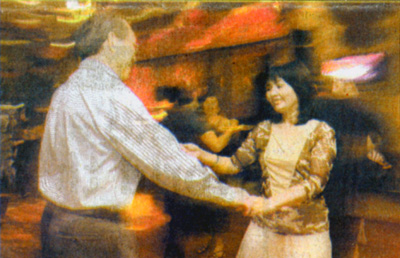

IT'S JUST A BIG, blocky building, like so many others in Emeryville. But unlike the nearby Ikea and Denny's, it draws a decidedly different crowd.
Tuesdays is for tangoers. Thursday, salsa dancers. Fridays brings in the foxtrotters. And Saturdays, the West Coast Swingers.
It's the Allegro Ballroom. And the joint is jumping.
"I used to peek in the window and look at people having a good time," says Greg Hulse, a 45-year-old entrepreneur from El Cerrito. "I mean, every night had something going on. I thought, 'Well, THAT'D that be nice to do.' But if you don't know how to dance, you have to find a humble hole to get your practice in before you can dance like that."
While Hulse has yet to step foot into the Allegro, he's taken one very important step in getting closer to his goal: He, like many others in the Bay Area of late, has searched out his own personal humble hole and is taking ballroom dancing lessons. He found his spot at the College of Alameda, where professional dancer Danny Nguyen teaches a very popular course on ballroom and social dancing.
"We only started four weeks ago, so I'm not perfect yet," warns Hulse, who recently posted an ad on CraigsList for a dance partner so that he can practice on nights when he doesn't have a ballroom class. "We're mainly working on the tango, the merengue, the cha cha and the salsa. I know enough to be dangerous. Like karate. Just enough to get me in trouble."
Inspired by movies like "Shall We Dance" and "Mad Hot Ballroom," and most obviously, the Olympics-rating-killer television show "Dancing with the Stars," amateur hoofers are flocking to ballroom dance studios around the country at a rate not seen since the early days following the Patrick Swayze film "Dirty Dancing" of 1987.
In fact, since the initial airing of last year's "Dancing with the Stars," a show based on the British original called "Strictly Come Dancing," chain establishments like Arthur Murray have enjoyed a national growth of 30 percent.
The phones of local studios, too, have been ringing off the hook. Like Redwood City's Imperial Dance Studio, where 21-year-old Cheryl Burke, who dances on "Dancing with the Stars" with Drew Lachey, began her ballroom training.
Further south, in Campbell, the Dance Spectrum is also struggling to handle the volume of calls it gets. And most people inquiring about lessons don't even realize it's the home studio for "Dancing with the Stars" professionals Jonathan Roberts and Anna Trebunskaya.

|
Sean Connelley—Staff photos
|
Trebunskaya might even be familiar to sports fans. She's the spunky partner of former 49ers wideout Jerry Rice, a retired athlete who has defied arthritic-looking hips, and with the help of the popular vote managed to make it to the final three of the competition.
Roberts, sadly, didn't last as long, and was booted along with celebrity partner Giselle Fernandez after week three.
The final airs Sunday at 8 p.m. on ABC-Channel 7.
"We have seen a huge increase in awareness of that fact that we're a studio in the area and we're actually getting more students that are calling or coming in and looking for lessons," says Spectrum owner Pam Butler, an amateur competitive dancer who performs with Roberts when he's not occupied with the television show. "They don't even know that Anna and Jonathan teach here. Most say they've always been interested in dancing, but with the show on, they've finally decided to get off the couch."
Like bell bottoms and velour, touch dancing, as ballroom dancing is often called, has had a couple of renaissances over the years. The first wave, the one inspired by "Dirty Dancing," even spawned a few mini-waves of its own, including a return to line dancing in cowboy bars in such incongruous places as New York City, along with an interest in the lambada, which made an appearance in night clubs for a few weeks there in the late'80s.
And it wasn't so long ago that the Bay Area and much of the rest of the country enjoyed the swing dancing craze of the mid- and late-'90s. Brian Setzer's remake of Louis Prima's "Jump, Jive an' Wail" squeezed into Billboard's Top 20 Rock Tracks chart in 1998 while zoot suits for guys and hose with seams for ladies became staples in the clubs.
"What happens with those surges is during an up-time, you attract people who've always been sort of thinking about it, always had a desire to dance, and the prevailing trendiness is what motivates them to get up and come in," says Butler. "I describe it as a continuously growing core group.
"A lot of the impetus for that growth is those surges. It's like the typical person starting a diet in January. In January, 70 out of 100 say they want to diet. By March, it's like maybe 30. It's just not as popular a time to diet."
In fairness, it would be a mistake to compare the current resurgence of ballroom dancing directly to the swing dancing phase from a few years back. The swing craze had people not only dancing the part, but dressing it, and whether the actual lure was the dance or the lifestyle became muddled. Out of practicality, that will never be the case with ballroom.
"You definitely don't walk down the street dressing as a ballroom dancer — you might be mistaken for having another occupation," says Butler of the ballroom costumes that are heavy on garish colors and sequins for women and leotards with navel-plunging necklines for men. "It's just not as close to normal attire as the swing dancing clothes are. And they're incredibly expensive at the competitive level. The people that commit to ballroom dancing know that. They've not only put their body where their mouth is, they've put their money, too. It's not for the faint of heart."
It's that required dedication that results in few shades of gray when it comes to ballroom dancing. You're in, or you're out. And by all accounts, once you're in and ballroom has its hooks in you, there's little chance of getting out.
Hulse, the gentleman taking a course at the College of Alameda, confesses he first took a ballroom class at Chico State but admits he had a lot of other courses, was too nervous to attend, and never got very good. But he kept being drawn back.
"I always thought it would be fun, and that it was something I'd never really tapped into," he says before demonstrating his moves during a class field trip for dinner and dancing last Friday at San Francisco's New Asia restaurant.
James Kleinrath, an amateur dancer from San Carlos, said he got involved because he was "40, divorced and looking for women."
"There were several things that drew me to dancing," says Kleinrath, who competes with his significant other, Melody Singleton, on the amateur level and with professional Alise Halbert from San Francisco's Metronome Dance Center on the pro-am circuit. "There's an incredible joy about moving to music and almost becoming one with the music. The second thing was that I had no idea how intricate and satisfying the lead and follow aspect of dancing could be. You could create a dance, a new dance, every time, as you went along."
Kleinrath is now 57, and he's not only a competitor, he's also the president of the Bay Area's chapter of USA Dance, the governing body for ballroom dancing in the United States. He also teaches dance to those who don't necessarily want to compete but do want to social dance.
He finds he has to warn new students that they're not going to be doing any gravity-defying leg kicks like "Dancing with the Stars" celebrity dancer Stacy Keibler, a pro wrestler, or fleet-footed grapevines like 98 Degrees singer Drew Lachey after a single lesson. Or even 10.
"On the show, there's a lot of emphasis on what we call flash and trash," says Kleinrath. "They're doing the tricks, and there are a couple reasons for that. First, people not very knowledgeable about dancing are very impressed by them, and second, the actual techniques take much longer to master. And keep in mind that Stacy, in particular, has had years and years of ballet training."
Butler adds that she and her staff, who all work at the Dance Spectrum on a contract basis, have to be very candid with beginners.
"What you have to understand is that the celebrities that are performing on the show — they're doing exactly that. They're performing. One routine, one time," says Butler. "They're not learning to dance. Their bodies are not being trained to the technical aspects so they can pick up another dance and build on from a foundation. They learn one routine that maybe a month later, they wouldn't be able to do."
Still, there's no shortage of interest, even by professional dance studios, in "Dancing with the Stars." Most studios' Web sites refer to the show and several encourage their students to watch and vote. Even Kleinrath, who thinks "Dancing with the Stars" is a bit too heavy on the hype and "way too TV," admits he's predicted not only the show's two finalists, but its winner.
"Drew is good, but I think Stacy will win it," he says. "There's a disadvantage when you have to lead, even in the Latin dances when the man and woman's roles are more equal. Drew and Cheryl are to be commended, but it's hard to overcome all that training that Stacy's had."
You can e-mail Candace Murphy at cmurphy@angnewspapers.com or call (925) 416-4814.